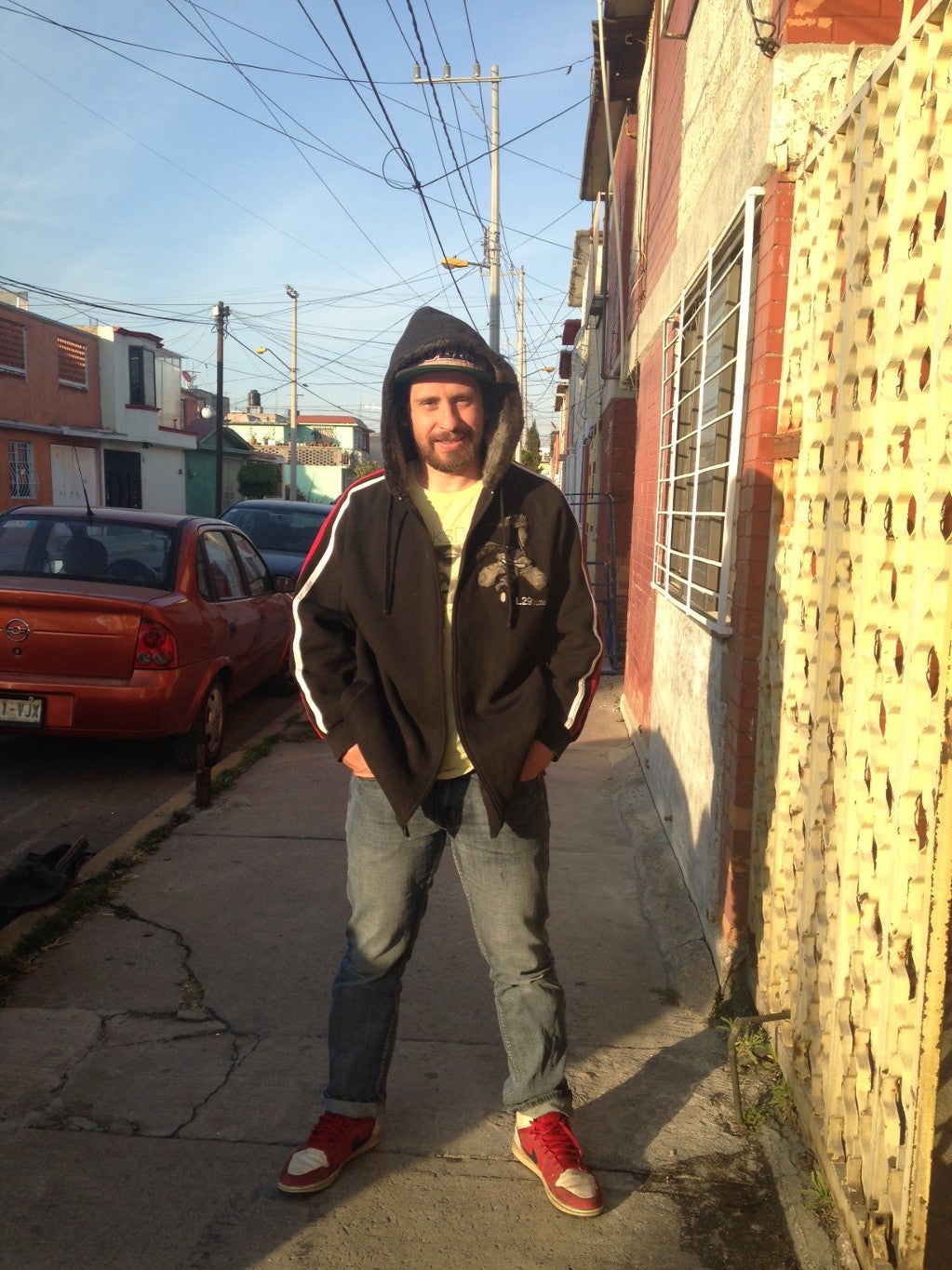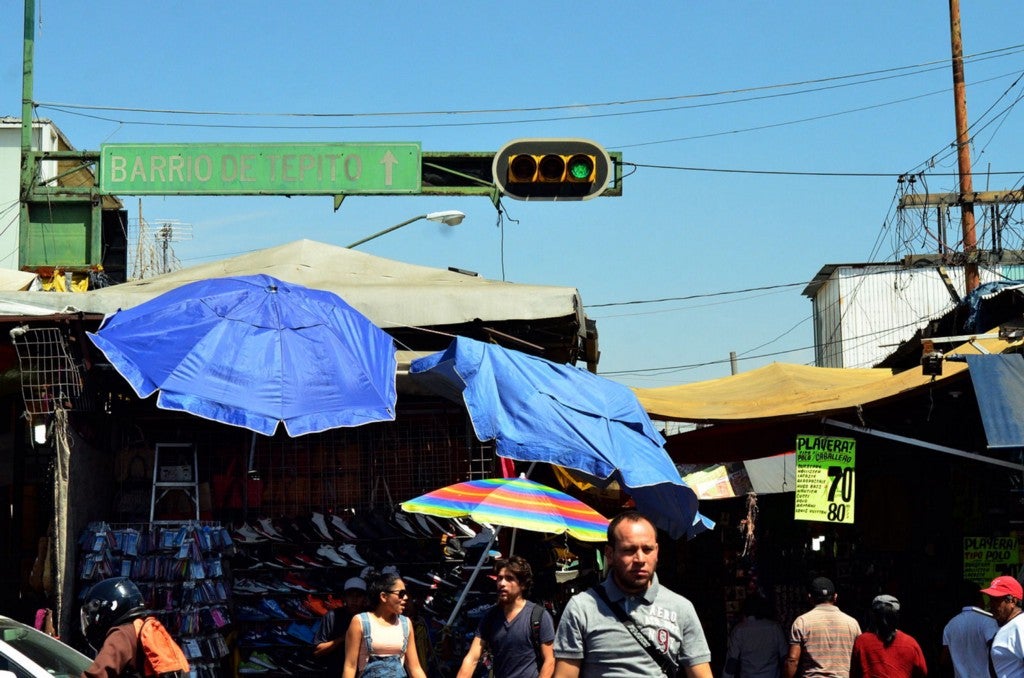I emerge from the subway with my father-in-law, Papa Pedro, onto Avenida Reforma, a huge, bustling six-lane street in Tepito, a barrio in Mexico City that’s also home to one of the most dangerous street markets in the world. Makeshift vendor stands with colorful tarps line both sides of the street. Several old pairs of tennis shoes hang from the electrical wires overhead. The scent of sewage mixes with the mound of diced pork sizzling in a nearby taco stand. It seems kind of normal — save for the several hundred riot police who stand guard as far as the eye can see.
To stay as safe as possible — if not inconspicuous — I’ve borrowed my brother-in-law’s Chicago Bulls baseball cap and his furry Wile E. Coyote hoodie so as to look like a typical reggaetonero Chilango (a Mexico City guy who listens to reggaetón). It was my wife’s idea; she wanted me to hide my gringo-ness so I wasn’t robbed and/or kidnapped. She also instructed me not to speak and to keep my hood up and head down as much as possible.

She was the one who first told me about Tepito — back about 10 years ago when we were still just dating. Almost immediately afterward, I asked if we could go. “No way,” she replied. “Tepito is too dangerous. They’ll rob you, and if you fight, they’ll kill you. The last time I was there I saw an American guy walking around, and this little guy came up and tried to rob him. The American guy fought back when all of the sudden everybody around — even the shop workers — attacked him.”
Even so, my brother-in-law, who at the time was a tough reggaeton DJ, took me to Tepito for the first time about a year later. It became something of a family tradition for a few years: Dress up the gringo in a disguise and go to Tepito. But these days Omar is a chef in Playa del Carmen, so this year it’s just Papa Pedro and me.
Since Papa Pedro is from a tougher generation, he opts for his usual dress — blue jeans, a nice striped shirt and dress shoes. We’ve come here together in search of something I consider a quality leather briefcase, but that my wife’s family calls a mariconera (or man purse). I want something stylish on a budget, and in Tepito, you can get designer leather — or knock-off designer leather — for a fraction of the price. “If a truck full of goods gets stolen, you can be certain they will end up in Tepito,” says 32-year-old Jacqueline Alvarado, a mother of two whose family has lived in the neighborhood for generations.
Tepito has a centuries-long history with both street markets and crime. The market predates Spanish colonization back to when the Aztec Empire ruled from what is now Mexico City (and was then called Tenochtitlan). The origin of the name Tepito comes from the police, who when going on patrol in the neighborhood, would say, “Si veo un ratero te pito.” (Translation: “If I see a thief, I’ll blow my whistle.”) Mexico City combined the last two words to make the name Tepito when the never-ending police whistles became synonymous with the neighborhood. All that whistling also helped fortify Tepito’s adversarial relationship with the police, which is alive and well to this day.
“When we catch a police officer in this market we have to string them up,” Alberto Perez, a 45-year-old lifelong Tepito resident whom I met through a friend, tells me. “We grab them, we tie them up and suspend them from the nearest light pole to humiliate them and send a message to the rest.” To clarify, Perez and the others don’t kill the cops or hang them from their necks. They just tie them up and suspend them until police reinforcements arrive and take them down — humiliated, but alive.
“That’s true,” confirms Alvarado. “The cops know not to go inside. There, the law is in the hands of the people of Tepito.”
Today, robbery in Tepito comes in two forms. The first is when a thief on a moped snakes through the market and does a snatch-and-accelerate. The locals are so used to it that when they hear the motor rev, they dive for cover inside a shop. The second is more personal and bloody. “The muggers are everywhere,” says Alvarado. “When they find someone they want to rob, they follow them and use a system of whistles to communicate. When the victim is near an empty courtyard, they rob them at gun- or knifepoint and sometimes beat them as well.”
The good thing for me is that I barely have enough cash on me to buy a mariconera. Papa Pedro and I also decide to start off in a section of the market with a safer reputation as far as muggings go. We stop for a quick breakfast at a dirty stand that serves egg-and-diced-hotdog tacos with rice. When I don’t order a second round of tacos, Papa Pedro laughs and says, “No te gustan!” (You didn’t like!) He then informs the cook of the same thing while I try to argue the exact opposite. But the damage is done, and the cook glares at me with a cold, I-will-kill-you-motherfucker stare. We quickly pay before Papa Pedro’s joke backfires on the both of us.
On our way back to the core markets of Tepito, Papa Pedro and I pass a big light blue boxing gym. “Tepito tiene muchas campeones,” says Papa Pedro. (There are many champion boxers from Tepito.) Tepito’s toughness isn’t only relegated to crime; the symbol for the subway stop there is a boxing glove because it’s home to several world-renowned boxing gyms that have produced Hall of Famers like Marco Antonio Barrera and Carlos Zarate as well as a bunch of other world champions and ranked contenders.

Someone behind us whistles. I look, but no one is there. I do, however, begin to notice a strange looking man in all black with a backpack, brimmed hat and dark sunglasses. He’s in front of us; he’s behind us. He even bumps into me a couple of times.
Another whistle sounds off ahead of us. I tell Papa Pedro I have to use the bathroom. When we find one, he sits down at a nearby restaurant for a bottle of Coke. I notice two guys laying on the cracked concrete floor. Their faces and heads bear the brunt of a recent, savage beating. One is unconscious. A nasty blackened cut spans across his whole cheek below his eye. The other one is attempting to care for him, though his wounds aren’t much better. His hand is broken, and all his fingers are zig-zagged.
As I leave the bathroom, the man in black is thumbing through some plastic sleeves of DVDs for Rogue One and other movies still in American theaters. Between him and Papa Pedro’s firm conviction that all the mariconeras are on the safer side of Tepito, I decide it’s best to move along. That, of course, is the exact moment I see a line of four leather Armani mariconeras. “That one!” I tell Papa Pedro.
“No, we’ll go see the others and come back,” he responds.
I ignore him, and tap at the one I want for the vendor.
“Cuanto?” I ask.
“1,300 pesos.”
That’s about 60 bucks.
Unfortunately, I only have a little more than half of that on me. Papa Pedro grows frustrated: “William, we will go to the other side, and if you don’t find something better, we’ll come back and I’ll loan you the money.”

I just want to get the fuck out of there so I offer the vendor 1,000 pesos.
“1,100,” he says with a sigh.
I shrug and start to walk away. “Okay, okay,” the vendor shouts.
We come back, and Papa Pedro opens his wallet as the man in black slowly passes behind us. Thankfully, there’s only about 500 pesos in it. We pay the vendor, and I watch the man in black slowly disappear into the market ahead of us, never to be seen again. We jump on the subway. The first train is nearly empty, and I sit down next to Papa Pedro with my mariconera on my lap — its metal fittings and quality zipper shining in the subway light. We made it out alive. Even better? I got a deal. It turns out my mariconera is selling online for $500 USD — or about $440 more than I paid for it.
